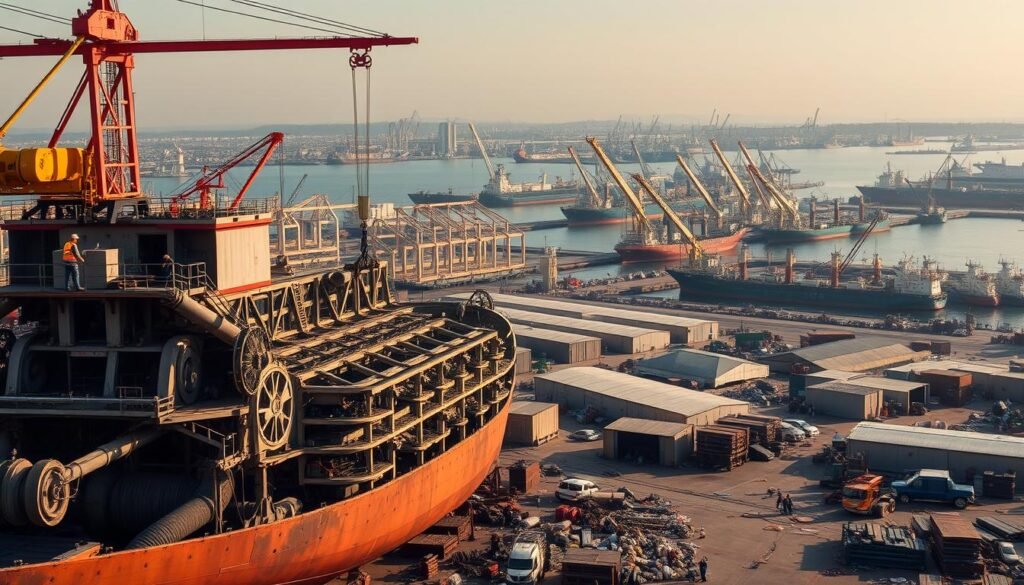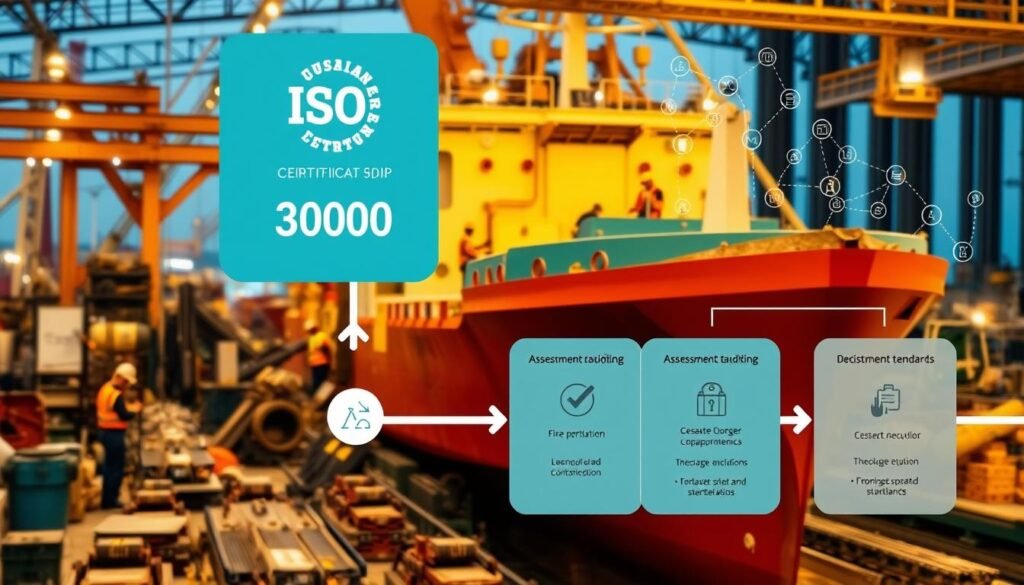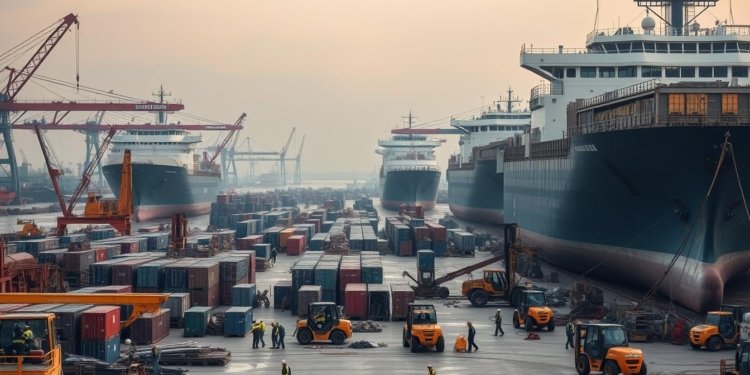What if the final voyage of a ship could be as responsible as its years at sea? Many believe ship recycling is just about dismantling old vessels, but there’s a deeper story about safety and sustainability.
The ISO 30000:2009 standard transforms this process. It sets up a complete management system for ship recycling facilities. This ensures every step follows strict rules for safe and environmentally sound operations.
This approach covers everything from accepting ships to handling waste materials. It protects worker health and prevents pollution. The standard also supports global sustainability goals.
Organizations using this framework show their commitment to responsible practices. They follow international requirements for certification and continuous improvement.
Key Takeaways
- ISO 30000:2009 creates a management system for safe ship recycling operations
- The standard covers the entire process from vessel acceptance to final disposal
- It emphasizes environmental protection and worker safety throughout recycling
- Certification demonstrates compliance with international requirements
- The framework supports sustainable development goals for oceans and industry
- Proper implementation reduces waste and prevents pollution
- Facilities must maintain ongoing training and documentation for certification
Introduction to ISO 30000 Ship Recycling Standards
When ships reach the end of their service life, their final journey matters just as much as their voyages across oceans. The international framework for responsible vessel disposal establishes clear guidelines for facilities worldwide.

What is the ISO 30000:2009 Standard?
This international specification creates a complete framework for recycling operations. It covers every step from vessel acceptance to final material processing.
The standard establishes requirements for hazard assessment and worker training. It also addresses waste management and documentation controls. Facilities can demonstrate conformity through third-party verification.
The Importance of Environmentally Sound Ship Recycling
Proper recycling prevents harmful materials from entering ecosystems. It protects coastal communities and marine life from pollution.
The management system ensures safe handling of all components. This approach supports resource recovery and reduces environmental impact. Organizations following these practices show commitment to sustainability.
Global Impact and Sustainable Development Goals
Responsible ship recycling contributes to several United Nations objectives. It promotes decent work conditions and protects underwater life.
The standard aligns with international maritime conventions and national regulations. Proper implementation helps achieve climate action and responsible consumption goals. This creates positive effects for global industry and ocean health.
Key Requirements of ISO 30000 Certification
Achieving certification under this international framework demands meeting rigorous operational standards across multiple facility areas. The requirements cover every aspect of ship dismantling and material recovery.
Comprehensive Management System Specifications
The standard establishes a complete framework for recycling operations. This system must integrate all facility processes from vessel acceptance to final material handling.
Each recycling facility must document procedures for every operational phase. The management system ensures consistent application of safety and environmental protocols.
Safety and Environmental Protection Measures
Facilities must implement thorough hazard assessment for incoming vessels. This includes identifying potential risks from materials and ship structures.
Environmental protection measures prevent pollution during dismantling operations. The standard requires containment systems for hazardous substances.
Regular monitoring ensures compliance with both national and international regulations.
Worker Health and Social Amenities Requirements
The certification mandates comprehensive worker health protections. Facilities must provide medical services and regular health checks.
Social amenities include proper nutrition provisions and first aid services. These requirements ensure safe working conditions throughout the recycling process.
Waste Management and Documentation Controls
Proper waste handling systems are essential for certification. Facilities must separate and process different material types appropriately.
Documentation controls track the entire recycling operation from start to finish. This includes material inventories and disposal records.
The system ensures transparency and accountability in all recycling activities.
The ISO 30000 Certification Process
The journey toward ISO 30000 certification begins with a thorough evaluation of current operations and documentation systems. This comprehensive process ensures facilities meet all international requirements for safe and environmentally sound ship recycling.

Initial Assessment and Documentation Review
Facilities start by completing detailed assessment questionnaires. These documents evaluate current practices against standard requirements.
The review examines existing procedures for vessel acceptance and material handling. It also checks training records and safety protocols.
Proper documentation forms the foundation for successful certification. Facilities must organize all operational records systematically.
Two-Stage Audit Process Explained
Stage one involves document verification by certified auditors. They review management system documentation and implementation plans.
Stage two consists of an in-depth facility audit. Auditors observe actual operations and interview personnel at all levels.
This two-stage approach ensures both paperwork and practices meet standards. Successful completion leads to certificate issuance.
Maintaining Certification and Ongoing Compliance
Certification requires three-year assessment cycles for renewal. Facilities must demonstrate continuous improvement during this period.
Regular internal audits help maintain compliance between assessments. These checks ensure the management system remains effective.
Ongoing monitoring procedures track performance metrics. Facilities must address any non-conformities promptly.
Training Requirements for Ship Recycling Facilities
Comprehensive training programs cover all aspects of safe operations. They include hazard identification and emergency response procedures.
Different personnel levels receive specialized instruction based on their roles. Supervisors get additional management system training.
Training must integrate with actual operational practices regularly. Facilities document all training activities for audit verification.
Costs vary based on facility size and operational complexity. The investment ensures long-term compliance and operational excellence.
Conclusion
Responsible vessel dismantling represents more than just industrial processing – it’s a commitment to planetary stewardship. The international framework establishes comprehensive management system requirements that protect both workers and marine environments.
Certification demonstrates a facility’s dedication to safe and environmentally sound operations. This approach transforms potential waste into valuable resources while preventing pollution.
The standard supports global sustainability through improved working conditions and ocean protection. Facilities pursuing this certification contribute to industry innovation and responsible consumption goals.
Adopting these practices ensures long-term benefits for coastal communities and marine ecosystems. This commitment to excellence represents the future of responsible maritime industry practices worldwide.
FAQ
What is the ISO 30000:2009 standard?
The ISO 30000:2009 standard is a management system for ship recycling. It provides a framework for safe and environmentally sound operations. This standard helps facilities manage risks and protect workers.
Why is environmentally sound ship recycling important?
Environmentally sound ship recycling prevents pollution and protects ecosystems. It ensures hazardous materials are handled safely. This practice supports global sustainability efforts.
How does ISO 30000 support sustainable development goals?
This standard promotes responsible resource recovery and waste reduction. It aligns with goals for clean oceans and safe working conditions. Facilities contribute to broader environmental and social targets.
What are the key safety requirements in ISO 30000 certification?
Key safety requirements include proper handling of hazardous materials and emergency preparedness. Facilities must provide protective gear and training. These measures ensure worker health and prevent accidents.
What does the certification process involve?
The process starts with an initial assessment and documentation review. A two-stage audit checks compliance with all standard requirements. Facilities must demonstrate ongoing adherence to maintain certification.
Are there specific training requirements for ship recycling facilities?
Yes, staff must receive training on safety procedures and environmental protocols. Training ensures everyone understands their roles in maintaining compliance. Regular updates keep practices current with standards.





